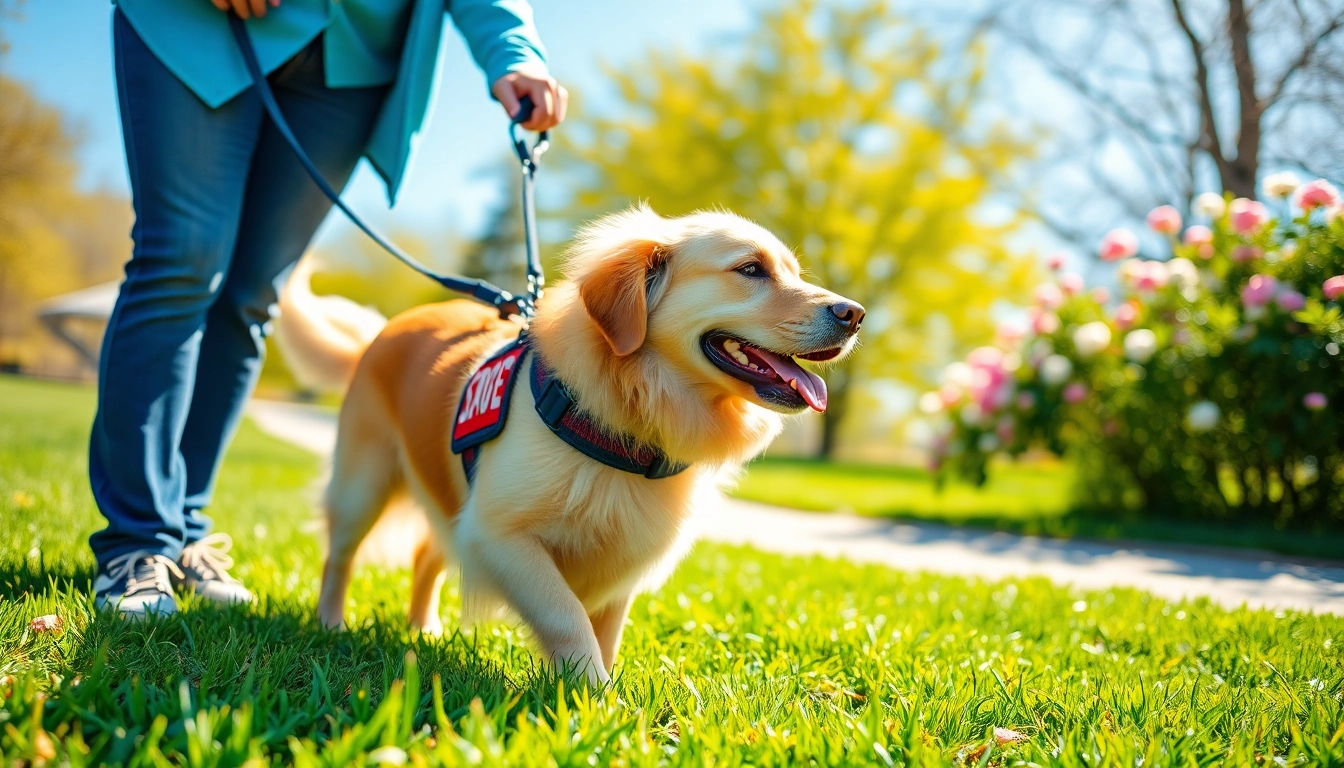Understanding Service Dogs
Service dogs are specially trained animals that perform tasks to assist individuals with disabilities. These loyal companions not only provide emotional support but also enhance the independence and quality of life of their owners. If you are considering the option to get a service dog, it is crucial to understand what these dogs are, the different types available, and the legal rights associated with them.
What is a Service Dog?
A service dog is defined as a dog that is trained to perform specific tasks for an individual with a disability. Under the Americans with Disabilities Act (ADA), service dogs are recognized as working animals, not pets. They are trained to execute tasks that help individuals with physical, sensory, psychiatric, or intellectual disabilities.
Examples of tasks may include guiding individuals with vision impairments, alerting deaf individuals to sounds, pulling a wheelchair, giving help during seizures, and reminding individuals with mental illnesses to take their medication. The unique bond between a service dog and its owner enhances the capability of individuals to manage their conditions and lead fulfilling lives.
Types of Service Dogs Available
There are various types of service dogs tailored to meet the needs of individuals with different disabilities. Here are some common types:
- Guide Dogs: Trained to assist individuals with visual impairments.
- Hearing Dogs: Alert individuals who are deaf or hard of hearing to important sounds.
- Mobility Assistance Dogs: Help individuals with physical disabilities navigate daily activities, such as opening doors and retrieving items.
- Psychiatric Service Dogs: Trained to help individuals cope with psychiatric conditions like PTSD, anxiety, and depression by providing grounding, alerting, and comfort.
- Medical Alert Dogs: Trained to alert their handlers about incoming medical emergencies, such as seizures or diabetic episodes.
Legal Rights and Regulations
Service dogs are granted rights under the ADA, which allows them to accompany their owners in public spaces where pets are typically not allowed. This includes restaurants, stores, and public transportation. However, it is important to note that emotional support animals (ESAs) and therapy dogs do not have the same rights as service dogs. Only service dogs specifically trained to perform tasks for their handlers are afforded such legal protections.
Service dogs must be identifiable as working animals. Though they are not required to wear a specific vest, many owners choose to use harnesses or tags that indicate their status as service animals. Furthermore, the ADA does not mandate that service dogs be certified, nor does it allow businesses to ask for proof of certification. They can only ask if the dog is required because of a disability and what tasks the dog has been trained to perform.
Eligibility Criteria to Get a Service Dog
Before deciding to get a service dog, individuals must assess their needs and determine whether they meet the eligibility criteria. This section details the key considerations in the process.
Assessing Your Needs
The first step is to evaluate if a service dog is appropriate for your specific circumstances. Consider the tasks you need assistance with and how a service dog could improve your day-to-day life. It’s also important to reflect on your lifestyle and living conditions to ensure that you could adequately care for a dog. Service dogs require regular exercise, training, and socialization.
Health Conditions That Qualify
Various health conditions may qualify an individual to get a service dog. Common conditions include:
- Visual impairments
- Deafness or hearing impairments
- Mobility challenges
- Severe anxiety or PTSD
- Seizure disorders
- Diabetes
It is essential to consult with a healthcare provider to discuss your qualifying condition and obtain documentation that confirms your need for a service dog.
Medical Documentation Requirements
To legally acquire a service dog, you must have medical documentation supporting your disability. This typically includes a letter from a qualified healthcare professional stating that you have a condition that necessitates a service dog. Documentation should briefly outline your diagnosis and the specific tasks the service dog will assist you with.
Some organizations may also require additional assessments or evaluations to determine your compatibility with a service dog before accepting your application.
Training and Certification for Service Dogs
Once you’ve determined your eligibility, the next step involves training and certification of your service dog. Understanding the nuances of training can help you ensure your future companion is well-prepared for the tasks you need them for.
Finding Qualified Trainers
It is crucial to find a reputable trainer who specializes in training service dogs. Look for trainers who are certified through recognized organizations, such as the Assistance Dogs International or the National Association of Dog Obedience Instructors. A qualified trainer will have experience in training dogs for specific tasks related to your disability.
When selecting a trainer, consider their training methods, the success rate of their service dogs, and reviews from previous clients. Arrange meetings with potential trainers to discuss your needs and ask about their training programs specifically designed for service dogs.
Types of Training Programs
Training programs vary widely based on the needs of the individual and the tasks that the service dog needs to perform. There are generally two types of training programs:
- In-House Training: This involves sending your dog to a training facility where professionals can train the dog on your behalf.
- Owner Training: Some individuals prefer to train their service dogs themselves. This approach allows for a closer bond and hands-on training. However, it requires a commitment of time and energy, as well as a reliable training program or support from a professional
Regardless of the choice, consistent training, socialization, and reinforcement of desired behaviors are essential for a service dog to be effective.
The Certification Process Explained
While there is no formal certification process mandated by law for service dogs, many organizations offer certification programs. These programs evaluate the dog’s abilities, behaviors, and reliability during a series of tasks. Successful completion of a certification program can provide a sense of accomplishment and reassurance to the owner. It also gives additional confidence to the public regarding the dog’s training.
Even if an official certification is not sought, an owner should ensure that their service dog is well-behaved in public and responsive to commands. This is essential for both the safety and well-being of the service dog and the public.
Financial Considerations When You Get a Service Dog
Acquiring and caring for a service dog involves financial commitments that go beyond the initial training and acquisition costs. Understanding the financial implications is essential for prospective owners.
Cost of Training and Care
The costs associated with getting a service dog vary greatly depending on factors such as breed, training, and placement organization. On average, training a service dog can range from $10,000 to $30,000. This may include costs for training, veterinary care, grooming, food, and supplies.
Furthermore, ongoing living expenses must be accounted for, including regular veterinary visits, insurance, and training refreshers. Service dogs may also require specialized equipment, such as harnesses or other assistive devices, depending on their tasks.
Possible Funding Sources
For individuals concerned about the costs of acquiring a service dog, various funding sources exist to assist with expenses. Nonprofit organizations often provide financial assistance or subsidies for eligible individuals seeking a service dog. Some possible funding avenues may include:
- Grants: Certain foundations offer grants to cover service dog training and care.
- Fundraising: Engaging friends, family, or community members via platforms like GoFundMe can help raise funds.
- State and Local Programs: Check for local programs that may provide support for service dog expenses.
Insurance and Assistance Programs
Health insurance policies may cover some medical expenses associated with having a service dog, but this varies between providers and policies. It’s advisable to review your policy or speak to an insurance representative to determine eligibility. In addition, social service programs may also provide resources or funding to help with expenses related to service dogs.
Many organizations that train and place service dogs also offer their own financial assistance programs to help participants cover costs, so inquire when considering your options.
Steps to Apply for a Service Dog
Understanding the application process is integral to getting a service dog. Following these steps can simplify the process and help ensure you find the right match for your needs.
Choosing the Right Organization
Research to find an organization that aligns with your needs. Organizations vary in their training methods, types of service dogs offered, and eligibility criteria. Getting recommendations from healthcare providers, community groups, or online resources can help streamline your search. Review the organization’s mission, success rates, and client testimonials to ensure they are reputable and suitable for you.
Completing the Application Process
Once you select an organization, prepare your application. Most applications will require details about your medical condition, your daily life, and the specific tasks you need assistance with. Be as thorough as possible in documenting your needs to help the organization assess your request accurately. Also, gathering necessary medical documentation and references can expedite the application process.
Preparing for Your New Companion
After acceptance into a program, you must prepare for the arrival of your service dog. Create a suitable environment for your new companion by gathering supplies such as dog food, bowls, beds, toys, and necessary training materials. Familiarize yourself with training protocols and establish a routine to help your service dog settle into your home effectively.
Lastly, practice patience and flexibility as both you and your service dog adjust to your new partnership. Establishing a bond and building mutual trust is essential for a successful relationship.



